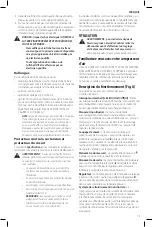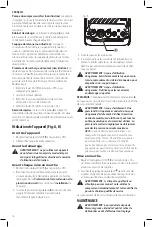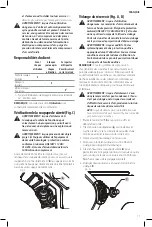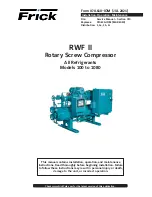
English
2
IMPORTANT SAFETY INSTRUCTIONS
SAVE ALL WARNINGS AND
INSTRUCTIONS FOR FUTURE
REFERENCE
DANGER: RISK OF EXPLOSION OR FIRE
What can happen
how to prevent it
It is normal for electrical contacts
within the motor and pressure
switch to spark.
Always operate the unit in a
well ventilated area free of
combustible materials, gasoline, or
solvent vapors.
If electrical sparks from unit come
into contact with flammable
vapors, they may ignite, causing
fire or explosion.
If spraying flammable materials,
locate unit at least 20 feet
(6.1 m) away from spray area.
An additional length of hose may
be required.
Store flammable materials in a
secure location away from unit.
Restricting any of the unit
ventilation openings will cause
serious overheating and could
cause a fire.
Never place objects against or on
top of unit pump.
Operate unit in an open area at
least 12" (30.5 cm) away from
any wall or obstruction that would
restrict the flow of fresh air to the
ventilation openings.
Operate unit in a clean, dry well
ventilated area. Do not operate unit
in any confined area.
Unattended operation of this
product could result in personal
injury or property damage. To
reduce the risk of fire, do not allow
the unit to operate unattended.
Always remain in attendance with
the product when it is operating.
Always turn off and unplug unit
when not in use.
CAUTION:
RISK FROM NOISE
What can happen
how to prevent it
Under some conditions and
duration of use, noise from
this product may contribute to
hearing loss.
Always wear certified safety
equipment: ANSI S12.6 (S3.19)
hearing protection.
DANGER: RISK TO BREATHING
(Asphyxiation)
What can happen
how to prevent it
The compressed air directly from
your unit is not safe for breathing.
The air stream may contain
carbon monoxide, toxic vapors, or
solid particles from the air tank.
Breathing these contaminants can
cause serious injury or death.
Air obtained directly from the unit
should never be used to supply air
for human consumption. In order
to use air produced by this unit
for breathing, suitable filters and
in-line safety equipment must be
properly installed. In-line filters
and safety equipment used in
conjunction with the unit must
be capable of treating air to all
applicable local and federal codes
prior to human consumption.
Exposure to chemicals in dust
created by power sanding,
sawing, grinding, drilling, and
other construction activities may
be harmful.
Work in an area with good
ventilation. Read and follow the
safety instructions provided on the
label or safety data sheets for the
materials you are spraying. Always
use certified safety equipment:
OSHA/MSHA/NIOSH respiratory
protection designed for use with
your specific application.
Sprayed materials such as paint,
paint solvents, paint remover,
insecticides, weed killers,
may contain harmful vapors
and poisons.
WARNING: RISK OF BURSTING
Air Tank:
On February 26, 2002, the U.S. Consumer
Product Safety Commission published Release # 02-108
concerning air compressor tank safety:
Air compressor receiver tanks do not have an infinite
life. Tank life is dependent upon several factors, some of
which include operating conditions, ambient conditions,
proper installations, field modifications, and the level
of maintenance. The exact effect of these factors on air
receiver life is difficult to predict.
If proper maintenance procedures are not followed,
internal corrosion to the inner wall of the air receiver tank
can cause the air tank to unexpectedly rupture allowing
pressurized air to suddenly and forcefully escape, posing
risk of injury to consumers.
Your compressor air tank must be removed from service
by the end of the year shown on your tank warning label.
The following conditions could lead to a weakening of the
air tank, and result in a violent air tank explosion:
WARNING:
Some dust contains chemicals known
to the State of California to cause cancer, birth
defects or other reproductive harm such as asbestos
and lead in lead based paint.
What can happen
how to prevent it
Failure to properly drain condensed
water from air tank, causing rust
and thinning of the steel air tank.
Drain air tank daily or after each
use. If air tank develops a leak,
replace it immediately with a new
air tank or replace the entire unit.
Modifications or attempted repairs
to the air tank.
Never drill into, weld, or make
any modifications to the air tank
or its attachments. Never attempt
to repair a damaged or leaking air
tank. Replace with a new air tank.
Unauthorized modifications to
the safety valve or any other
components which control air
tank pressure.
The air tank is designed to
withstand specific operating
pressures. Never make adjustments
or parts substitutions to alter the
factory set operating pressures.
Содержание BTEC25200
Страница 35: ......





































